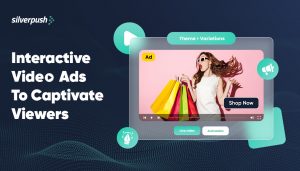Good things DO NOT come to those who wait
PUBLISH DATE: 18 January 2024
In the fast-paced world of advertising, the saying “Good things come to those who wait” couldn’t be further from the truth. In an era where technology evolves rapidly, and consumer behavior constantly shifts, advertisers clinging to outdated and monotonous campaign strategies may find themselves drifting away from valuable business opportunities.
Discover the Trends Taking Over in 2024
As we step into 2024, it becomes imperative for advertisers to discern and leverage key trends to maintain a competitive edge in this dynamic arena.
Brace yourself for the cookie countdown
The global digital advertising market was valued at $601.8 billion in 2023, with media ads accounting for 67.1% of overall expenditure. Clearly, digital advertising is a lucrative industry, and it’s no surprise that more companies are finding ways to capitalize on this trend. However, as more companies seek to tap into this thriving trend, it’s essential to address the impending challenge of cookie deprecation and its potential impact on advertisers and digital advertising revenue.
Google has outlined its plan to phase out third-party cookies entirely by the conclusion of 2024, and efforts are already underway to implement this transition. The initial measure involves the introduction of Privacy Sandbox Tracking Protection, which will be experienced by 1% of Chrome users globally. This feature aims to restrict cross-site tracking by default.
Focus will be more on Personalization and Hyper-Targeting
“One-size-fits-all” approach won’t be effective anymore. With abundance of information and choices consumers today expect to be catered with relevant ads, they want brands to directly speak to them based on their interests, needs and preferences.
70% of consumers expect personalization and 56% agreed that personalized experience motivates them to become a repeat customer. (Source)
From a business point of view, personalisation helped 77% of businesses increase their market share. This form of marketing has increased conversions nearly 50% for brands. (Source)
Brands that don’t invest in understanding their audience and delivering tailored content are at the risk of losing customer engagement.
Video Content Dominance
Video content will continue to dominate the existing ad formats, as billions of viewers tune in. According to stats, 2023 had seen a 23% surge in internet traffic volume globally, escalating usage of streaming videos. (source)
But, advertisers need to be mindful of the video length, as consumer attention span and patience is getting shorter. More than 25% of adults close a video after 10 seconds and approximately 50% of the viewers close it after 20 seconds. (source)
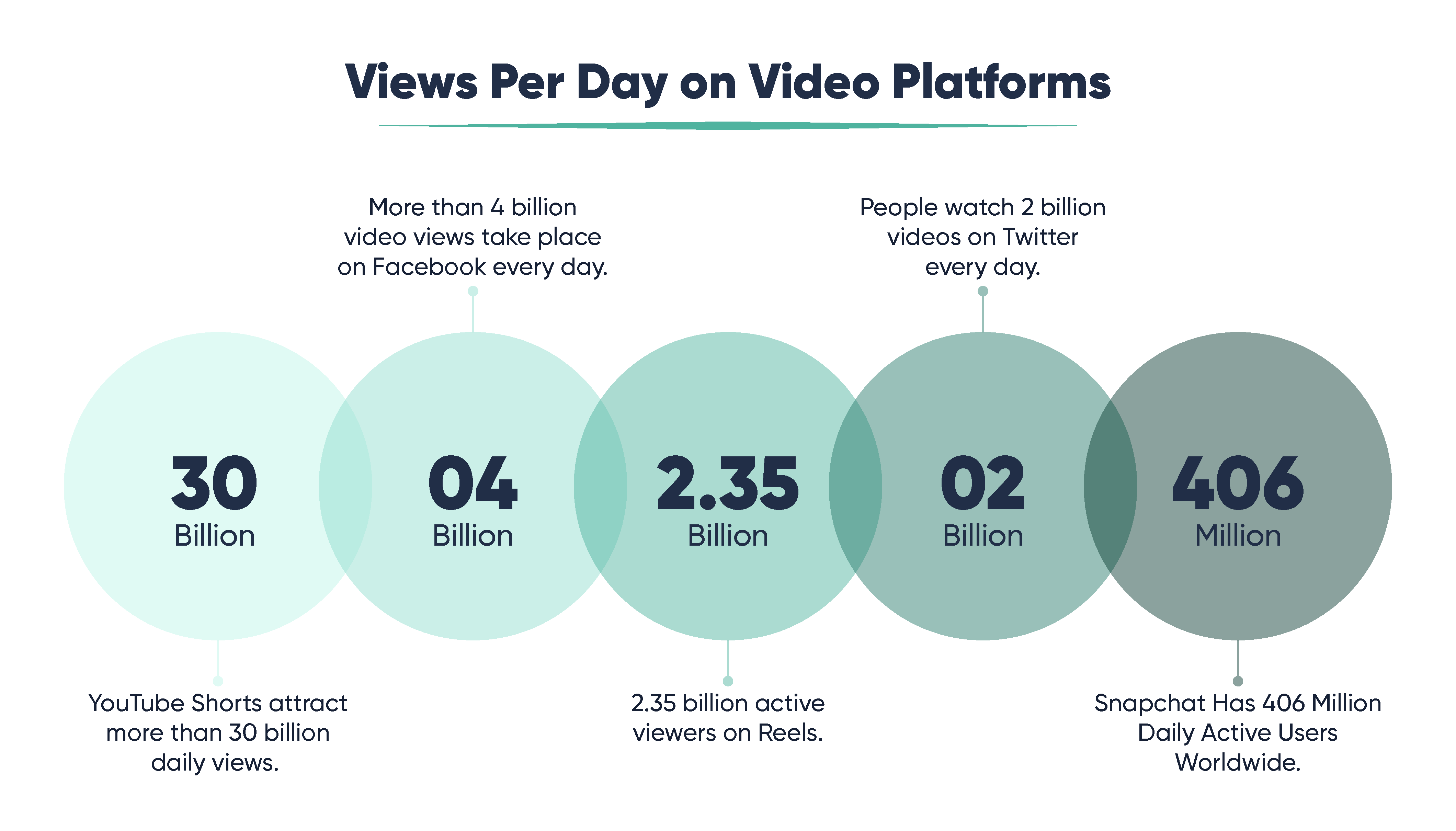
Brands should focus on creating high-quality and engaging video content for platforms like YouTube, TikTok, and Instagram. This trend is especially important as attention spans decrease, and visual storytelling becomes more critical.
Interactive Content
Since video content is gaining popularity advertisers need to advance their video advertising strategies. From the traditional video ads there is going to be an upgrade to dynamic interactive video ads.
To drive more engagement and conversion, advertisers should incline towards dynamic video ads as a result they have noted significant growth in their online sales.
Interactive content, such as polls, quizzes, and augmented reality experiences, not only captures attention but also provides a more immersive brand experience.
Among the interactive elements, shoppable TV ads have proven to be highly effective for cutting through the noise and boosting customer engagement due to their interactive nature. According to a survey, Shoppable ads have 55% ad recall and 50% interacting rate.
Role of Generative AI
Generative AI can process large amounts of data and generate valuable insights that can inform strategic decisions in campaign planning. Additionally, AI algorithms can analyze diverse datasets to identify and create new audience segments. Using these insights, advertisers can tailor their campaigns to specific demographics, ensuring more targeted and effective advertising.
Advertisers are using predictive analytics to analyze historical data and gain insights into user behavior, enabling them to optimize their campaigns further.
Conclusion
The advertising industry heavily relies on AI for campaign planning, execution, and optimization. Generative AI is changing the game by actively participating in the process. To achieve maximum success, brands should stay up-to-date with the latest trends in advertising and incorporate generative AI into their campaigns. This will provide advertisers with unparalleled levels of data analysis, audience segmentation, and dynamic content creation, leading to more efficient and personalized targeted advertising that can significantly boost the impact of campaigns. In a constantly evolving landscape, innovation is crucial to maintain growth and market dominance. Brands that embrace the potential of generative AI and adapt their strategies accordingly can exceed the expectations of the ever-changing consumer base. This will ensure a prosperous future in the dynamic world of advertising.
Unlocking the Full Potential of Video Advertising with Mirrors’ Dynamic Video Optimization
PUBLISH DATE: 28 June 2023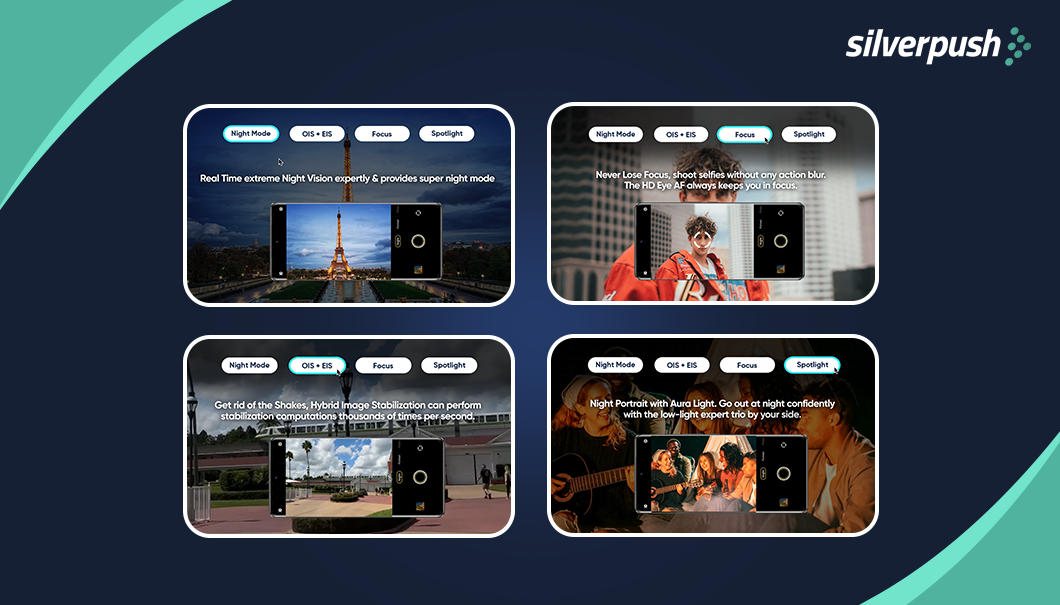
Crafters is here to transform traditional ads into highly advanced interactive ads with its cutting-edge dynamic video optimization.
With global ad spending expected to exceed $295 billion by 2026, video advertising has become an immensely popular method to connect with audiences online.
With over 2 billion active users worldwide, YouTube stands as the leading video advertising platform, hands down.
Unfortunately, engaging with users through video advertising on the open web is not as straightforward and convenient as it is with YouTube videos.
Read on to discover why video advertising on the open web is lagging behind and explore various methods that can help users unlock the full potential of video advertising across the web.
Factors Hindering Video Ad Promotion on the Open Web
Below are the reasons for hesitation in promoting video ads on the open web versus YouTube and other social media platforms:
1. Low Viewability
Video ads on the open web are often skipped or muted, resulting in low viewability rates. According to a study by IAB, the average viewability rate for video ads on the open web is only 58%. In contrast, the average viewability rate for video ads on YouTube is 95%.
2. Poor Targeting
Video ads on the open web lack precise targeting options because they rely on programmatic advertising based on website content and user browsing history which reduces advertiser control.
3. Lack of Engagement
Video ads on social media platforms are more engaging than those on the open web because they play uninterrupted.
Here are the top three reasons that have kept video advertising on the open web in the backseat. However, by modifying our advertising methods and incorporating advanced techniques such as dynamic video optimization, advertisers can witness significant improvements in their campaigns.
But, first, let’s understand DVO.
What is Dynamic Video Optimization?
Dynamic Video Optimization (DVO) is an innovative programmatic advertising approach that uses data-driven insights to create personalized video ads.
By analyzing user data, including interests, demographics, and browsing history, DVO enables advertisers to customize video content for each viewer.
Real-time analytics and contextual information are leveraged to tailor the ads based on the current context.
This personalized approach enhances the ad experience, increasing the likelihood of capturing viewers’ attention and driving conversions.
Consequently, DVO delivers relevant and engaging video content that resonates with individual viewers, maximizing the effectiveness of video advertising campaigns.
Why Should Advertisers Use Dynamic Video Optimization?

1. Advanced Targeting Capabilities
DVO offers advanced targeting capabilities, allowing advertisers to reach their desired audience with precision. Delivering video ads to the most relevant viewers increases the chances of engagement and conversions.
2. Enhanced User Experience
DVO enables advertisers to create immersive and interactive video ad experiences. By incorporating features such as shoppable touchpoints, users can seamlessly explore and purchase products or services directly from the video. This improves the user experience by eliminating the need for multiple clicks and streamlining the path to purchase.
3. Data-Driven Insights
DVO provides valuable data and insights that can inform advertisers’ future strategies. By tracking user interactions, engagement metrics, and conversion data, advertisers can gain a deeper understanding of their audience’s preferences and behaviors. These insights can then be used to optimize future video ad campaigns for better results.
4. Measurable Results
With DVO, advertisers have access to detailed analytics and performance metrics. This allows them to track the effectiveness of their video ads in real time, measure key performance indicators (KPIs), and make data-driven decisions to improve campaign performance. Advertisers can easily monitor CTRs, view rates, conversions, and other relevant metrics to evaluate the success of their advertising efforts.
5. Dynamic Storytelling
DVO enables advertisers to tell compelling stories through video ads. By leveraging dynamic content insertion and personalization techniques, advertisers can tailor their messages based on individual viewer characteristics, interests, or behaviors. This approach creates a more engaging and memorable experience for viewers, leading to higher brand recall and affinity.
6. Omnichannel Reach
DVO allows advertisers to reach their target audience across multiple platforms and devices. Whether it’s mobile, desktop, social media, or connected TVs, advertisers can deliver their video ads seamlessly across various channels, ensuring maximum reach and visibility.
Enhance Your Video Creatives with Silverpush’s Crafters
Crafters is Silverpush’s highly advanced dynamic video optimization technology. It is a solution for creating and delivering personalized video ads to users based on a variety of data sources.

We all know Videos are the most engaging Ad Format. But by infusing AI and unique Interactivity features, Crafters can help brands in leveraging Video Ads on the Open Web, like never before!
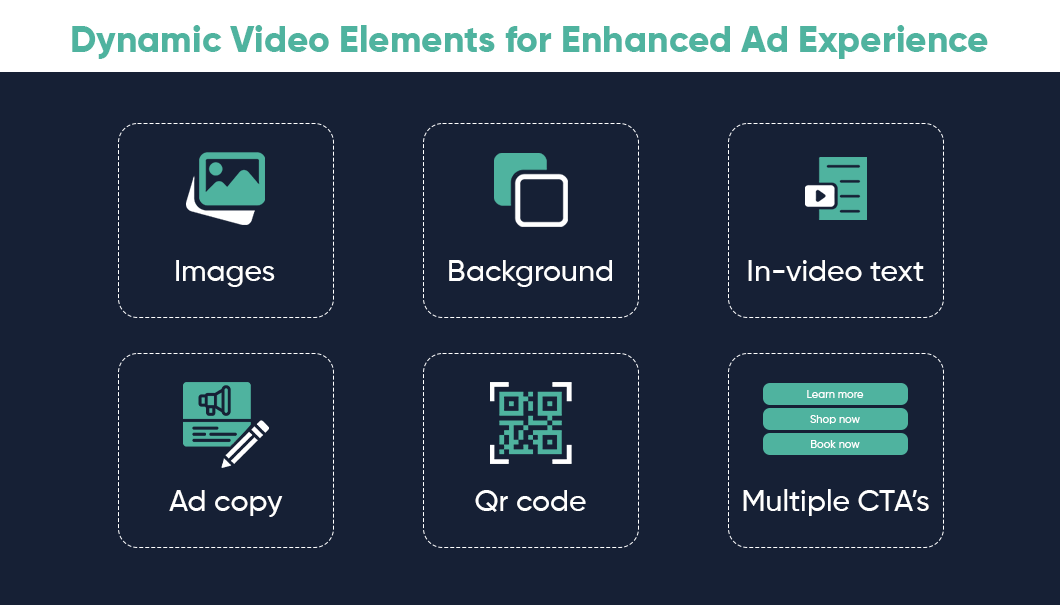
Crafters will help you improve the performance of video advertising campaigns by adding a layer of contextual creativity that will drive better business outcomes.
Here are some additional tips for using DVO effectively:
1. Use the Right Data
The data you use to create your DVO campaigns is critical to their success. Make sure you’re using high-quality data that is relevant to your target audience.
2. Test Different Variations
Once you’ve created your DVO campaigns, test different variations to see what works best for your audience. This will help you optimize your campaigns for maximum results.
3. Track your Results
It’s important to track the results of your DVO campaigns so you can see what’s working and what’s not. This will help you make adjustments to your campaigns to improve your results.
Importance of Crafters: Elevate your Performance and Engagement on Video Ads
1. Advertisers
Our next-gen video optimization technology solves the problem of ads being ignored by audiences. By incorporating an interactive feature into traditional video ads, it has the potential to generate users’ curiosity and encourage them to engage with the ad. This leads to improved performance metrics such as click-through rates, lead generation, and video view-through rates.
2. Users
Users will not only view the video ad but will have various formats to interact with the ad as per their interest, ad type, and various options to redirect to the desired page.
Conclusion
With the advertising world growing at a fast rate, it’s important to keep pace. Traditional video ads fail to engage users or boost user engagement. That’s why Silverpush has developed an advanced solution delivering a staggering 2X increase in Click-Through Rates (CTRs) and an impressive uplift of nearly 60% in Video Completion Rates (VTRs) solving the problems of video advertising on the open web. Take a step towards boosting your ad performance and capturing audience attention by filling out the form on the right. Our team of experts will be in touch with you shortly to provide more insights into our groundbreaking technology.
How to Create Relevant Contextual Ads with Mirrors Generative AI
PUBLISH DATE: 15 June 2023
Let’s face the truth: THIRD-PARTY COOKIES ARE LONG GONE!
Advertisers need to drastically shift from conventional targeting methods (requiring audience data) to privacy-focused strategies without compromising on delivering relevant ads.
Traditional targeting methods relied on cookies to reach targeted audiences by building a detailed profile of their online activity.
Growing data privacy concerns and the implementation of regulations like CCPA and GDPR raise the dilemma – how to balance between delivering personalized and relevant ads while respecting user privacy?
Enters Mirrors Generative AI, the next-gen contextual planning tool capable of discovering audiences without cookies and reaching them precisely in contextually relevant moments. The highly advanced tool was recently launched by Silverpush at its Cannes Lions 2023 debut.
Amplifying Relevance and Reach with Generative AI-Powered Contextual Advertising
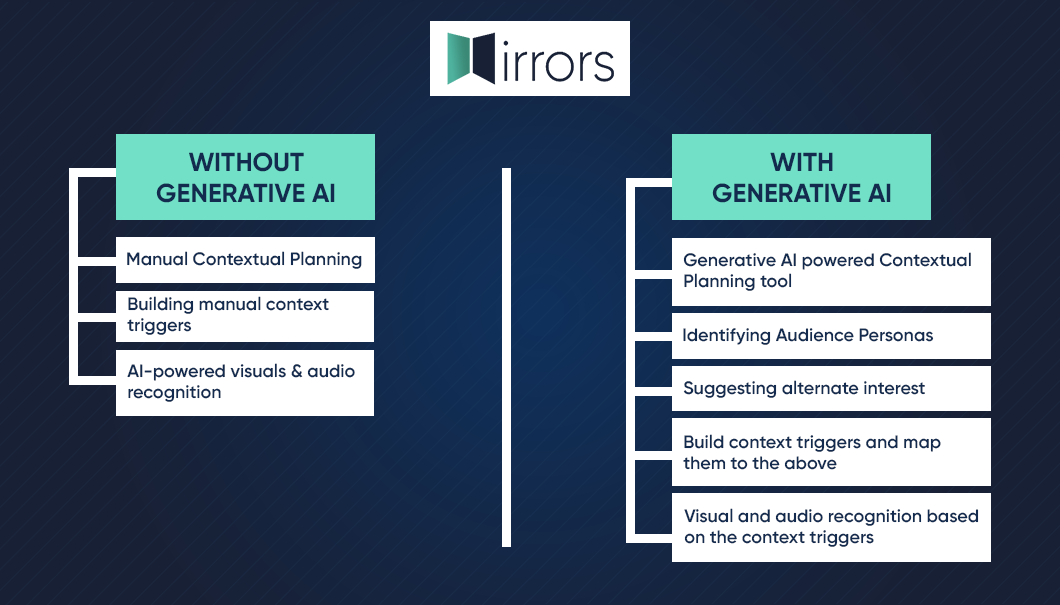
Mirrors, the flagship product of Silverpush, has recently integrated Generative AI into its contextual advertising technology to help brands reconnect with their untapped audiences.
It is a revolution that will boost the ever-present contextual intelligence by discovering newer audience personas without any human bias, guesswork, or stereotypes of the past.
By leveraging its predictive AI technology, Mirrors goes beyond the basics and delves deep into the content consumption habits of the target audience.
Utilizing advanced generative AI technology, Mirrors carefully analyzes videos and identifies key contexts in webpages, surveys, and a wide range of content on the open web, examining each word with precision.
This enables Mirrors to uncover patterns, decipher meaning, and extract valuable insights that surpass surface-level understanding.
Challenges Faced by Advertisers in Finding Contexts Manually
To maximize engagement, advertisers aim to target diverse audience personas based on their specific interests, timing, and context. However, relying on manual context-building methods has certain limitations.
1. Scale and Complexity: Manually creating context triggers for a large volume of content can be a time-consuming and complex task. Advertisers may struggle to keep up with the constantly evolving content landscape and the need to identify and update relevant triggers across various platforms and channels.
2. Subjectivity and Bias: Manual context trigger creation involves human judgment, which can introduce subjectivity and bias. Advertisers may have different interpretations of content, resulting in inconsistent or inaccurate context triggers that may not align with the intended audience or message.
3. Limited Contextual Understanding: Fully comprehending the context of every piece of content manually can be challenging. Advertisers may miss subtle nuances, references, or trends that could impact the appropriateness of ad placement.
4. Resource Intensity: Creating and managing manual context triggers requires dedicated resources, including skilled personnel, time, and effort. Advertisers may face limitations in terms of available resources, hindering their ability to effectively build and maintain comprehensive sets of context triggers.
5. Timeliness and Real-time Updates: Content evolves rapidly, and new trends and topics emerge regularly. Advertisers may struggle to keep their manual context triggers up to date, leading to potential misalignment between ads and current content relevance.
6. Scalability and Adaptability: As advertising campaigns scale and expand across different platforms and channels, managing manual context triggers becomes more challenging. Advertisers may find it difficult to adapt their triggers to new formats, channels, or emerging content types.
Eliminating Human Bias and Automating Context Discovery
The real power of Mirrors Generative AI lies in its ability to seamlessly integrate AI as a co-pilot to human intelligence. The advanced technology builds a comprehensive context list, well aligned with the audience’s personas and their direct and alternate interests. This enables advertisers to reach untapped/overlooked yet relevant audiences, resulting in enhancing incremental reach.
Why Plan Your Next Campaign With Mirrors Generative AI?
1. Cookieless Audience Discovery: The contextual planning tool will enable advertisers to identify contextually relevant audiences without relying on third-party cookies.
2. Scale without Compromise: Better contextual relevance leads to improved audience understanding, which can often be overlooked. By tapping into these overlooked audiences, advertisers can enhance their reach and engagement.
3. Understand Multicultural Audience: Mirrors Generative AI uses diverse datasets to assess performance across races and cultures. Then, analyzing metrics and understanding the emotional impact, bias, inclusion, and purchasing intent. This generates audience personas and passion points, offering advertisers valuable insights for informed decision-making.
4. Create Highly Customized Campaigns: Utilizing Mirrors Generative AI offers the opportunity to go beyond pre-defined taxonomies and gain unparalleled flexibility in creating highly customized campaigns.
Ready to Experience 3X Audience Expansion with Mirrors Generative AI?
It’s your time to broaden your audience reach with Mirrors Generative. To know how our advanced tool can boost your ROI fill and widen your reach with precision out the form on the right.
Contextual Advertising: Optimal Targeting Method for High ROI and Less Ad Waste
PUBLISH DATE: 13 June 2023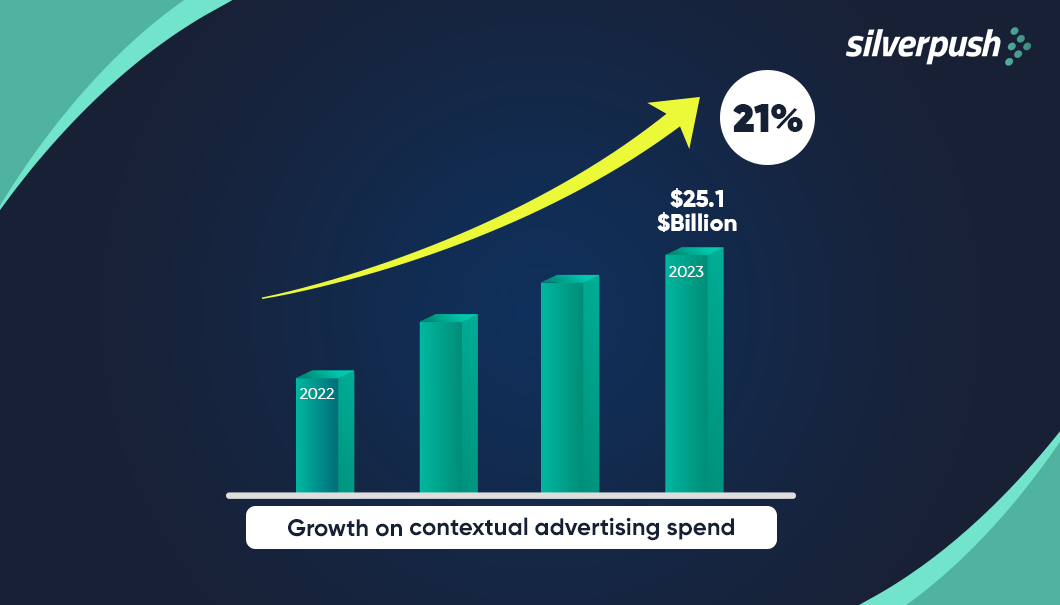
Brands employing contextual advertising have witnessed improved conversion rates, engagement levels, and click-through rates, after shifting from conventional targeting methods. Hope, you are not stuck with the latter!
Table of Contents
1. Introduction
2. How does Contextual Advertising Work?
3. How can Going Contextual Benefit your Business?
4. Statistics Highlighting the Importance of Contextual Advertising
5. How to Choose the Right Contextual Advertising Technology?
6. Silverpush’s Next-Gen Contextual Advertising Solution, Mirrors
Introduction
With the booming contextual advertising industry, brands now have a golden opportunity to capitalize on this trend. The ban on third-party cookies has undoubtedly played a significant role in shaping this evolving landscape.
A staggering 65% of respondents are more likely to be converted by advertisements that align with the content of the web page they’re viewing!
Contextual advertising possesses the ultimate power to engage audiences effectively.
This is a call to all thriving brands, advertisers, and agencies who are eager to unlock the true potential of their advertising budget. It’s time to bid farewell to aimless shots in the dark and instead achieve precision by reaching your intended audience at the right time and in the right place through hyper-contextual advertising strategies.
Before we delve deeper into this topic, let’s start with the fundamentals. Get ready to make every click count and leave your competition in awe.
What is the Meaning of Contextual Advertising?
As per, the Interactive Advertising Bureau (IAB) contextual advertising is “a form of advertising that delivers ads based on the content of the page where they appear.”
In simple words, contextual advertising is a type of online advertising that displays ads based on the page content where they are shown. To gain a deeper understanding of contextual advertising make sure to explore our comprehensive blog on Contextual Advertising: The Advertising Industry’s Next Big Step.
Example of Contextual Advertising
Have you ever found yourself engrossed in an article about automobile servicing and later seeing a car ad on some other platform, say social media? That’s the magic of contextual advertising in action! Displaying ads that align with users’ interests, thus increasing the chances of capturing attention, boosting clicks, and ultimately driving conversions.
How does Contextual Advertising Work?

The process of contextual advertising involves 7 key steps:
1. Content Analysis: Contextual advertising platforms employ sophisticated algorithms to analyze the content of web pages. This analysis includes identifying key contexts in the text, images, and other elements to understand the context and themes of the page.
2. Keyword Identification: Relevant keywords are extracted from the page’s content, which helps determine the overall topic and subject matter.
3. Ad Matching: Based on the identified keywords and context, contextual advertising platforms match relevant ads from advertisers’ campaigns that align with the webpage’s content.
4. Ad Display: Once the appropriate ads are selected, they are dynamically displayed on the webpage alongside the relevant content. These ads can appear in various formats, such as banners, text-based ads, or multimedia ads.
5. User Engagement: Users who visit the webpage have the opportunity to engage with the displayed ads by clicking on them, which directs them to the advertiser’s landing page or website.
6. Performance Tracking: Contextual advertising platforms track the performance of the ads, monitoring metrics such as click-through rates (CTR), conversions, and overall campaign success. This data helps advertisers optimize their campaigns and improve targeting.
7. Continuous Refinement: Contextual advertising systems continually refine their algorithms and keyword analysis techniques to enhance ad relevancy and provide a better user experience.
How Contextual Targeting Can Benefit Your Business?

Contextual targeting delivers relevant ads to desired audiences, improving performance, customer experience, and brand presence online. Here’s why it’s the top choice for brands:
1. Privacy-Centric Policies
As we can witness the heightened customer demand for privacy, it is important for brands to prioritize privacy-focused approaches. Contextual targeting acts as a tried-and-true, privacy-friendly alternative to help brands reach their targeted audiences without the need for cookies.
2. Brand Safety
Brand safety is a non-negotiable aspect for advertisers. By placing ads on relevant content and in a safe environment, advertisers protect their brand image and avoid any potential legal liabilities. Contextual advertising, which utilizes comprehensive context identification on videos or webpages before placing ads, serves as an effective means to maintain brand safety.
3. Specialized Targeting
A study by Forrester Research found that personalized ads can increase click-through rates by up to 100% and conversion rates by up to 200%. However, with a reduced amount of user data available to brands, creating personalized ads will take time and effort. Contextual targeting is an apparent way to maintain an effective digital ad campaign while avoiding the use of personal data because of its capability to target niche audiences.
4. Less ad fatigue
Utilizing contextual advertising can effectively mitigate ad fatigue by reducing the frequency of ad displays. This is achieved by ensuring that ads are only shown on relevant websites, minimizing the chances of users repeatedly encountering the same ads. By targeting ads based on contextual relevance, brands can provide a more refreshing and engaging advertising experience, avoiding the potential negative effects of ad fatigue.
5. Improved Customer Experience
Implementing contextual advertising can significantly enhance the customer experience by delivering relevant information aligned with their specific interests. By leveraging contextual cues, such as the content they are engaging with, brands can provide targeted and valuable messaging to their customers.
6. Frequency Capping
Frequency capping in advertising limits how often a specific ad is shown to an individual within a set time frame. It prevents overexposure, ad fatigue, and annoyance, striking a balance between reaching the target audience and avoiding excessive repetition that hampers campaign effectiveness.
Statistics Highlighting the Importance of Advertising Contextually
1. The global contextual advertising market is expected to reach $376.2 billion by 2027, growing at a CAGR of 13.3% from 2022 to 2027.
2. The United States is the largest contextual advertising market, accounting for 32.76% of the global market in 2021.
3. 74% of marketers are using contextual data to improve their advertising post-device ID and post third-party cookies on the web.
4. 79% of consumers are more comfortable seeing Contextual than behavioral ads.
5. About 80% admitted they were more open to seeing ads not requiring their data.
6. 62% of US marketers are using contextual marketing today. (Up from 49% in 2022)
7. 42% of brands plan to increase their spending on contextual ads in 2023.
8. Contextual ads are 50% more likely to be clicked on than non-contextual ads.
9. Contextual ads have a 30% higher conversion rate than non-contextual ads.
How to Choose the Right Contextual Advertising Technology?
When initiating the search for a contextual advertising partner, it is crucial to begin by asking potential providers the following key questions:
1. Do you consider video, audio, and images for brand safety and contextual classification, in addition to text?
2. Can you provide research or evidence that validates the effectiveness of your contextual advertising approach?
3. Do you own your technology, or are you relying on a third-party solution?
4. Does your technology possess the capability to understand the complete context of a web page or content?
5. Are you solely relying on keywords to identify context, or do you employ more advanced techniques?
By seeking answers to these questions, you can gather valuable insights into a potential contextual advertising partner’s capabilities, technology ownership, effectiveness, and credibility, allowing you to make an informed decision when selecting the right partner for your advertising needs.
Silverpush’s Next-Gen Contextual Advertising Solution – Mirrors
Silverpush is an advertising technology firm at the forefront of AI-powered contextual solutions. Their world’s first in-video context identification technology, Mirrors analyzes videos to empower brands and agencies with precise audience targeting in the cookieless world.

The company is built on three key pillars: contextual advertising across various platforms, ensuring brand safety, and upholding the value of consumer privacy. By leveraging contextual advertising, Silverpush enables brands to deliver tailored messages to the right audiences, while maintaining a secure and privacy-focused environment.
With an impressive track record, Silverpush has collaborated with renowned brands such as Ford, Nestle, Coca-Cola, and Samsung. Operating in over 18+ countries spanning South East Asia, the Middle East, Africa, the USA, the UK, and India, they have established a strong global presence.
Also read: Silverpush’s Contextual Approach to Sustainable Digital Advertising
Mirrors – AI-Powered Contextual Technology for Omnichannel Advertising

Mirrors, the flagship product of Silverpush is a hyper-contextual targeting strategy that uses AI/ML (computer vision and Natural Language Processing) to identify key contexts (brands, celebrities, places, objects, etc.) for nuanced-level targeting. During the process, content-aligned ad placement, brand safety & suitability compatibility are all guaranteed, along with reaching the largest possible audience.
Generative AI
Silverpush has incorporated Generative AI into Mirrors to provide brands with an effective solution to target without the use of cookies. To know more about the integration, click here.
Wrapping Up – The Future of Advertising is Contextual
Contextual advertising is a transformative force within the advertising industry, offering the ability to create impactful and engaging ads. In an era where data privacy has become paramount, digital advertising is shifting towards understanding the human mind.
This shift benefits consumers, as ads are presented to them precisely when they are receptive to a brand’s message, rather than incessantly tracking their online activities and relying on past behaviors.
In this new era, where personalization meets privacy, contextual advertising emerges as the perfect solution. It allows brands to connect with consumers in a meaningful way, delivering relevant messages that resonate and forge deeper connections.
Ace Back to School Advertising with the Power of Context
PUBLISH DATE: 31 May 2023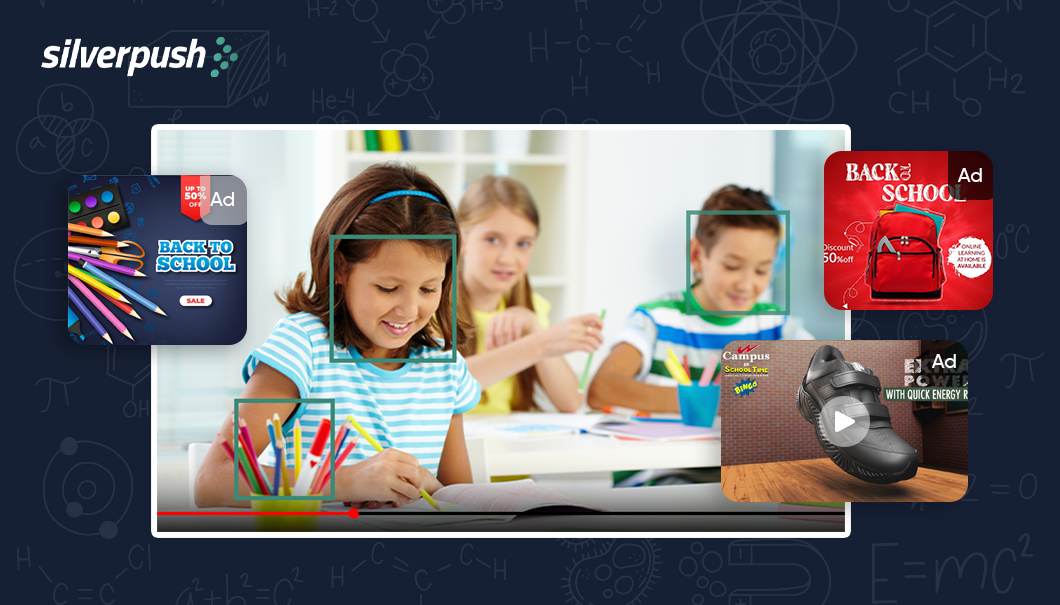
It’s time to secure an A+ in your back to school advertising! Captivate your audience and establish your brand as the go-to choice with contextual advertising.
As students in the United States prepare to say goodbye to their summer freedom and head back to school, parents are bracing themselves to say goodbye to their paycheck.
Returning to school after a refreshing and long summer break is one of the most important times of the year for both students and parents.
Whether it’s stocking up on stylish new school clothes to checking off every item on the school supply list, the retail industry recognizes the excitement and significance of this time of year, which requires loads of preparation.
As the school bells ring and summon students back to the back-to-school premises, it’s time for the brands to return as well.
Seizing the opportunity during this prime time, amidst the return of rival brands armed with improved targeting strategies and ads, how do you plan to connect with your targeted back-to-school shoppers precisely at the right moment, place, and with the perfect message? Look no further than Mirrors AI-powered contextual advertising to guide the way!
Who are the Back to School Shopping Audiences?
1. Parents
2. College Students
3. Teachers and Educators
4. School Administrators and Decision-Makers
5. Online Influencers and Bloggers
6. Early Childhood Education Centers
7. Adult Learners
Also read: Targeting Back-to-School Shoppers with Contextual Advertising
What are the Back to School Shopping Trends of 2023?
Some back-to-school trends advertisers should consider while creating this year’s seasonal marketing plan.
1. The increasing popularity of online shopping. More and more consumers are choosing to shop for back-to-school supplies online, as it is more convenient and often offers better deals.
2. Another trend is the growing importance of sustainability. More and more consumers are looking for sustainable options when shopping for back-to-school supplies. This means viewing sustainable ads or choosing products that are made from recycled materials or that are produced in an environmentally friendly way.
3. Shoppers are starting much earlier. Although the summer months still draw the heaviest activity, the back-to-school season now spans six months or even longer as many shoppers are:
-
- Buying early to avoid the pandemic-driven product supply issues of recent years.
- Taking advantage of sales events whenever they may occur.
- Trying to spread out their expenses over a longer period of time.
4. Parents have returned to physical stores. In-store shopping was expected to garner 49% of back-to-school sales in 2022 (versus 43% in 2021) when 42% of consumers told Deloitte they would only shop in physical locations (vs. 17% who would do it all online). That share of seasonal sales will likely increase again in 2023.
5. Finally, there is a growing trend towards personalization. More and more consumers are looking for back-to-school supplies that are personalized to their child’s interests. This means choosing products that feature their child’s favorite characters or sports teams.
Importance of Back to School Advertising for Brands
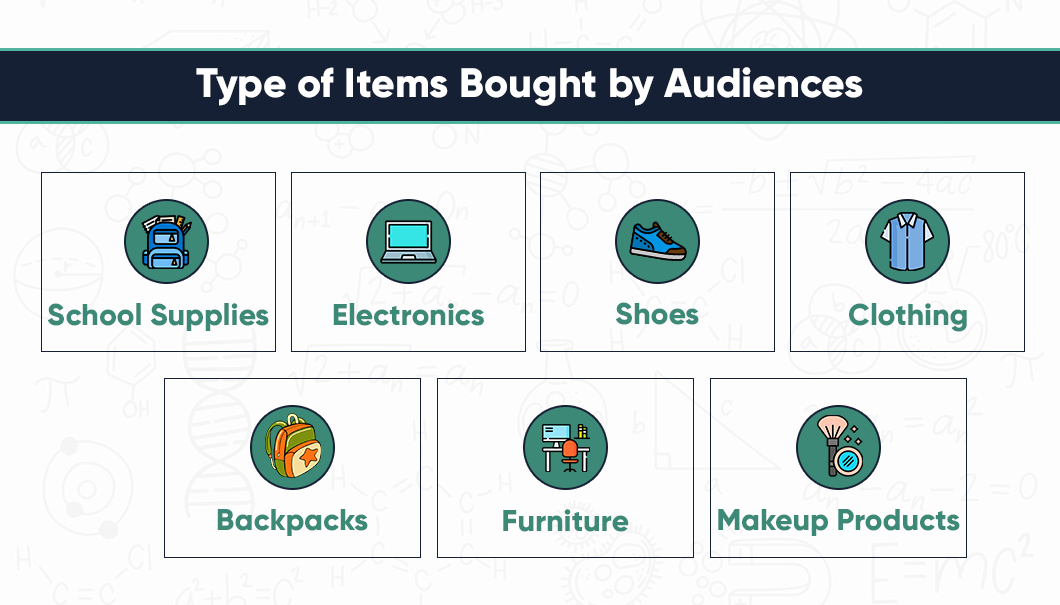
Back-to-school shoppers spent $168 more on school supplies in 2022, presenting a significant opportunity for the brand to expand reach and ROI. The compelling statistics will speak for themselves.
1. In 2022, the back-to-school season generated around $37 billion in sales in the United States.
2. The average family in the US spends $600 on back-to-school supplies.
3. 41% of shoppers planned an omni-shopping experience for desk/locker accessories, 35% in-store, and 25% online purchases.
4. 56% of back-to-school shoppers will start searching for supplies in early July and 88% of consumers are still waiting for their official school supply lists.
5. 8 in 10 consumers plan to use mid-July’s sales and events to shop for back-to-school supplies specifically.
Reach Where Your Targeted Back to School Shoppers Are
1. YouTube and Google are the top research platforms for shoppers before making purchases.
2. 25% of parents consult Facebook for BTS shopping inspiration.
3. US advertisers prioritized increased spending on social media (44%) and CTV/OTT (39%) for their back-to-school campaigns.
4. 62% of in-store purchases were consumables, compared to 10% online, with 28% of shoppers opting for an omnichannel shopping experience.
5. 41% of shoppers preferred an omni-shopping experience for desk/locker accessories, while 35% opted for in-store purchases and 25% chose online purchases.
Challenges of Using Traditional Methods for Back to School Advertising
1. Ad waste: Traditional advertising methods are exposed to a vast number of ads, making it difficult for advertisers to capture their attention and stand out from the competition.
2. Fragmented Audiences: Back-to-school shoppers can be found across various demographics and platforms, making it challenging for advertisers to reach them effectively using traditional methods. With the proliferation of digital channels and social media platforms, the audience is fragmented, and targeting specific segments becomes more complex.
3. Limited Targeting Options: Traditional advertising methods may offer limited targeting options compared to digital advertising. Advertisers may struggle to reach specific subsets of back-to-school shoppers based on their demographics, interests, and online behavior, resulting in wasted ad spend and reduced effectiveness.
4. Lack of Interactivity and Personalization: Traditional advertising methods typically lack interactivity and personalization, which are crucial for engaging back-to-school shoppers. Advertisers may struggle to create tailored and interactive experiences that resonate with their target audience, limiting their ability to establish a meaningful connection and drive conversions.
5. Difficulty in Message Customization: Traditional advertising methods often have limitations when it comes to customizing messages based on the unique needs and preferences of back-to-school shoppers. Advertisers may struggle to deliver personalized and relevant content that effectively communicates their value proposition.
Mirrors, Silverpush’s advanced hyper-contextual advertising technology, effectively targets and engages back-to-school shoppers. By intelligently identifying key contexts like celebrities, brands, texts, objects, and actions, Mirrors strategically places ads that deeply resonate with your desired audiences, reaching them at the right time and place with complete brand safety and suitability.

Final Words
The back-to-school season is an opportune time for brands to reach their targeted audiences at the time when they are most likely to engage with the ad and convert. Mirrors offers the solution you need to effectively engage with back-to-school shoppers. Simply fill out the form on the right, and our team will be in touch with you shortly to help you seize this valuable opportunity.
Cookieless Advertising: A Must-Include in Your Digital Advertising Diet
PUBLISH DATE: 19 May 2023
Hold on to your advertising hats, because big cookieless changes are coming to the digital ad landscape!
Many of us have experienced being followed across various social media platforms and other websites. And being given persistent personalized reminders to purchase a product after searching for it online.
What’s the reason behind it, ever given it a thought?
We all leave behind traces of data regarding our online activities, including the websites we visit and the searches we make.
Advertisers use this information to deliver personalized ads through a process called online behavioral advertising.
Basically, it’s done through the use of cookies, which are small files that are stored on our device when we visit a website.
Undoubtedly, cookies have helped fuel a multi-billion dollar online advertising industry. According to data, this well-worn digital tool has helped build digital advertising into a highly efficient $350 billion market.
But now as we witness the dawn of third-party cookies, what’s the new alternative targeting option for brands without taking a hit on their ROI?
This blog has all the answers you need. Read it till the end as you won’t want to miss a single detail about Silverpush’s omnichannel hyper-contextual advertising solutions helping brands thrive in the cookieless world.
Why is There a Need to Go Cookie-Less?
“Before cookies, the web was essentially private. After cookies, the web becomes a space capable of extraordinary monitoring,” said Lawrence Lessig 20 years ago.
For a long time now, advertisers have relied on cookies to monitor users across the internet and offer them customized ads based on their browsing behavior.
However, the usefulness of cookies is witnessing a downfall as they are heading toward obsolescence.
As per Google’s recent reports, by the end of 2024, Google’s Chrome browser is anticipated to restrict third-party cookies, which are already blocked on Safari and Firefox.
Google’s Chrome browser dominates the industry with a market share of over 60 percent in Europe and is widely used across multiple regions globally. As a result, we predict that Google’s proposed cookie policy is likely to spell the end of cookie-based advertising.
Advertisers will face a significant challenge as other tracking techniques also face mounting pressure. Notably, Apple’s app-tracking-transparency (ATT) framework already requires app providers to obtain explicit user consent before tracking them via device identifiers in the mobile app space.
Preliminary data suggests that only around 46% of consumers are willing to be tracked, and this percentage may be even lower in countries where privacy is a major concern for users.
The recent update in Apple’s policies means that app providers will face limitations in tracking users through device identifiers within the Apple ecosystem. Meaning, most users will not be trackable, which could have implications for targeted advertising and user profiling.
It’s worth noting that both Google and Apple have publicly stated that they will not support any attempts to create workarounds, such as probabilistic fingerprinting, to enable user-level profiling within their ecosystems.
Advertisers Need to Look Out for Themselves
It’s predicted that the elimination of third-party cookies and device identifiers will likely have a negative impact on advertising effectiveness and ultimately on the ROI for advertisers in the short term.
This will pose a significant challenge for brand marketers in sectors that are not closely tied to customer transactions, such as consumer packaged goods, automotive, and pharmaceuticals.
Despite the challenges, advertisers have several opportunities to strike a balance between precise targeting and accurate impact measurement while respecting consumer privacy.
Broadly speaking, implementing strategies that prioritize transparency and provide value to users in exchange for their data will most likely lead to success.
Many users are comfortable with personalized advertising as long as they are fully informed about the underlying mechanisms and not misled in any way. This approach can also help build consumer trust in the brand, which is a valuable outcome.
Upgrade your Advertising with Silverpush’s Hyper Contextual Cookieless Solutions
With the end of third-party cookies, advertisers need to shift to new solutions to engage with users in a privacy-safe and effective way.
Silverpush’s Mirrors offers contextual targeting solutions that deliver personalized ads to audiences without relying on their personal data. This ensures brand safety and relevance to the brand, even in a cookie-less environment.
Leverage the AI-powered solution of Mirrors by Silverpush to reach your relevant audience at the right time and place while respecting user privacy. Our platform guarantees complete brand safety and suitability on popular channels such as YouTube, OpenWeb, and CTV.
To learn more about how Silverpush can help you prepare for the cookieless world, simply fill out our form, and we’ll guide you toward successful advertising in a cookieless future.
How Contextual Advertising is Driving Sales in the Automotive Industry
PUBLISH DATE: 11 April 2023
Challenging. It is the correct word to describe how brands consider advertising in the automotive sector.
This is mostly due to the long purchasing cycle by consumers involving a large chunk of money coming out of their pockets.
Despite the challenges, automotive brands cannot afford to miss out on the immense consumer spending in this industry. In fact, the automotive industry is one of the largest spenders on advertising worldwide. According to a report by Statista, in 2020, the automotive industry in the United States alone spent a whopping 12.42 billion U.S. dollars on digital advertising.
Contextual advertising can be a highly effective strategy for automotive brands to reach their targeted audience in the right place, at the right time, and with the right message. This approach allows advertisers to target potential customers based on their interests, online behaviors, and purchase intent, without using their personal data.
What’s Unique About the Automotive Advertising Industry?
Before delving into automotive advertising strategies, it’s crucial to understand the unique nature of this industry.
Vehicles are a significant financial investment, and consumers often spend a considerable amount of time in the consideration phase. In fact, car buyers spend an average of almost 14 hours online during their research and visit around 4.2 websites before making a purchase decision.
As the buying journey almost always starts online, reaching potential customers with a programmatic campaign is essential long before they step foot in a car dealership.
Brands who want to reach their target audience need to first understand them. The target audience can vary depending on the type of vehicle being advertised. For instance, ads for luxury cars are targeted toward individuals with higher incomes, while family-friendly car ads are often aimed at individuals with lower to middle incomes who have families and need practical transportation options.
Also, the customer journey is an entirely complex process where customers rely on different platforms to get information about the car they are looking for.
For instance, a person interested in buying a car may watch advertisements for cars on Connected TV (CTV) using their mobile or desktop devices. To learn more about a specific car, they may browse online through OpenWeb to gather information about the car’s engine, features, and other details.
Additionally, they may ask for recommendations or advice from their friends on social media platforms like Meta to gain insights from other people’s experiences. By using multiple devices and platforms, the person can make a more informed decision when choosing a car that suits their needs and preferences.
This is where advertisers can leverage the situation to reach their target audiences at the right time and place when those audiences are most likely to be receptive to their ads and engage with them.
Contextual advertising is a powerful tool in the automotive industry, as it enables brands to understand the context of a webpage and tailor their advertising message accordingly. This can capture the customer’s attention at the right moment and potentially influence their purchasing decision. By leveraging contextual data and creating relevant and engaging ads, brands can make an impact and connect with potential customers in a competitive and challenging industry.
Maximizing Advertising Relevance with Mirrors’ Hyper Contextual Advertising
Silverpush’s flagship product – Mirrors is an AI-powered hyper-contextual technology that watches and listens (word-by-word), allowing you to target audiences with both precision and scale-ultimately driving better brand outcomes.
It ensures that your messaging reaches your users, during key decision-making moments which further amplifies the message and taps into users’ current state of mind. Thus, driving higher performance and efficiency for some of the largest auto brands in the world.
One of our major auto brands benefited greatly from our next-gen hyper-granular visual context targeting powered by AI and computer vision to leverage what auto consumers are watching on YouTube and drive trust and personal connection with a captive audience.
Plan an Omnichannel Marketing Strategy with Mirrors

Mirrors, the next-generation AI technology, offers brands a multi-platform solution to advertise across various channels, thereby extending their reach and amplifying their marketing efforts.
1. Open Web
Targeting audiences based on website content. Mirrors can also display ads based on the content of the user’s website. For example, if a user is reading an article about eco-friendly cars, contextual advertising can display ads for hybrid or electric cars.
2. YouTube
~ 90% of global shoppers surveyed say they discovered new brands or products on YouTube and 40% say they have purchased products they discovered on YouTube. Watch time of car videos on YouTube has grown by more than 65% in the past two years. When looking to buy a new car, consumers often turn to video research. Auto marketers can use this opportunity to reach potential buyers who are actively considering a purchase, even if they are not familiar with their product. Over 75% of auto shoppers say that online video has influenced their shopping habits and purchases.
3. Meta
By leveraging Artificial Intelligence (AI), Machine Learning (ML), and Natural Language Processing (NLP) models, Mirrors carefully selects and processes brand-safe Facebook pages to extract contextual signals that enable the delivery of real-time, in-the-moment ads with exceptional performance. This advanced technology empowers brands to serve highly relevant ads while ensuring brand safety on Facebook.
4. Connected TV (CTV)
Mirrors analyzes content, creates custom ad segments, and uses semantic analysis to display ads in premium and relevant CTV video inventory, avoiding misplacement based on user emotions and behavior.
Exploring Real-World Use Cases of Mirrors
1. How Mirrors Helped an Automotive Brand in Competitor Conquesting
An automotive car brand leveraged Mirrors’ AI technology to identify visual and audio cues related to key features of its competitors’ vehicles across different segments. With this information, the brand effectively targeted YouTube videos containing these cues and seamlessly insert their brand messaging. Furthermore, Mirrors trained its AI to recognize key players, team brands, and other sporting objects to help the brand capture the enormous viewership of YouTube game/race highlights, interviews, and other relevant content. By utilizing Mirrors, the automotive car brand efficiently and strategically reach its target audience while also gaining a competitive edge over its rivals.
2. Mirrors Enabled an Automotive Brand to Achieve Complete Brand Safety in Ad Display
Our client, an automotive car brand successfully utilized Mirrors to maintain brand safety while advertising on digital platforms. Mirrors’ AI technology performed a thorough analysis of YouTube video IDs, enabling us to go beyond broad keyword, category, and channel exclusions.
Mirrors’ pre-defined visual and audio context identification allowed us to exclude videos that did not align with our core values. By conducting video-level analysis, our AI became even more selective about when and where to block content, thus ensuring the perfect balance between brand protection and suitability.
Our brand safety standards, fully aligned with industry standards such as GARM, COPPA, CCPA, GDPR, and LDA compliance, were enhanced without over-blocking. Thanks to Mirrors, the automotive car brand effectively maintained brand safety while simultaneously maximizing our reach and engagement with our target audience on YouTube.
3. Automotive Brand Utilizes Video Analysis for Contextual Ad Placement

Mirrors helped an automotive brand reach and engage with its target audience interested in automobiles. By leveraging their competitors’ brands through trigger identification based on brands (of Hyundai, Chevrolet, Nissan, etc.), brand ambassadors, influencers, car-tech reviews, automobile showrooms, test drive videos, and more, Mirrors maximized the brand’s exposure in the market.
Through Mirrors’ advanced AI technology, the visual triggers were analyzed and ads were at the right place and moment, effectively targeting the relevant audience.
How Can Brands Benefit from Mirrors’ Hyper Contextual Advertising Technology?

Get Started With An Omni-Channel Marketing Strategy for Your Automotive Advertising
The greatest challenge for marketers in the auto industry is driving users through the often lengthy path to purchase. Since people today are online on a variety of devices, and using a variety of channels, it’s crucial to have coverage across multiple digital environments.
Multi-channel targeting enables advertisers to reach users across different platforms and channels. This helps a campaign achieve greater reach by capturing users wherever they are online.
Ready to drive auto advertising performance? Fill out the form on your right and your Silverpush representative will contact you soon with more information on how to get started.
Unlocking the Power of First-Party and Zero-Party Data: Future of Privacy-Focused Advertising
PUBLISH DATE: 30 March 2023
In 2023 expected data collection from the first-party and zero-party is 118 zettabytes.
Data is the backbone of modern marketing, providing brands with valuable insights into consumer behavior and enabling them to craft targeted campaigns that resonate with their audience.
However, the landscape is rapidly changing, with evolving privacy policies making it increasingly challenging to collect and utilize data in a manner that respects user privacy.
This new reality has given rise to contextual advertising, which offers a less invasive approach and is better aligned with evolving consumer preferences.
Also, inclining advertisers toward the first-party and zero-party data. By leveraging first-party and zero-party data, brands can still gain a deep understanding of their audience and create campaigns that deliver better results while abiding by the user’s privacy.
It’s interesting to note that contextual advertising is expected to witness significant growth in the coming years, with worldwide ad spending projected to reach 228 billion US dollars by 2023. One of the main drivers behind this growth is Google’s plan to phase out third-party cookies, which have traditionally been the cornerstone of behavioral targeting.
While third-party cookies have been an effective tool for advertisers to target consumers based on their browsing behavior, there has been growing concern over user privacy and data protection. As a result, privacy-focused browsers like Firefox and Safari have already blocked third-party cookies over a decade ago.
Explore the Alternatives for Third-Party Data Targeting
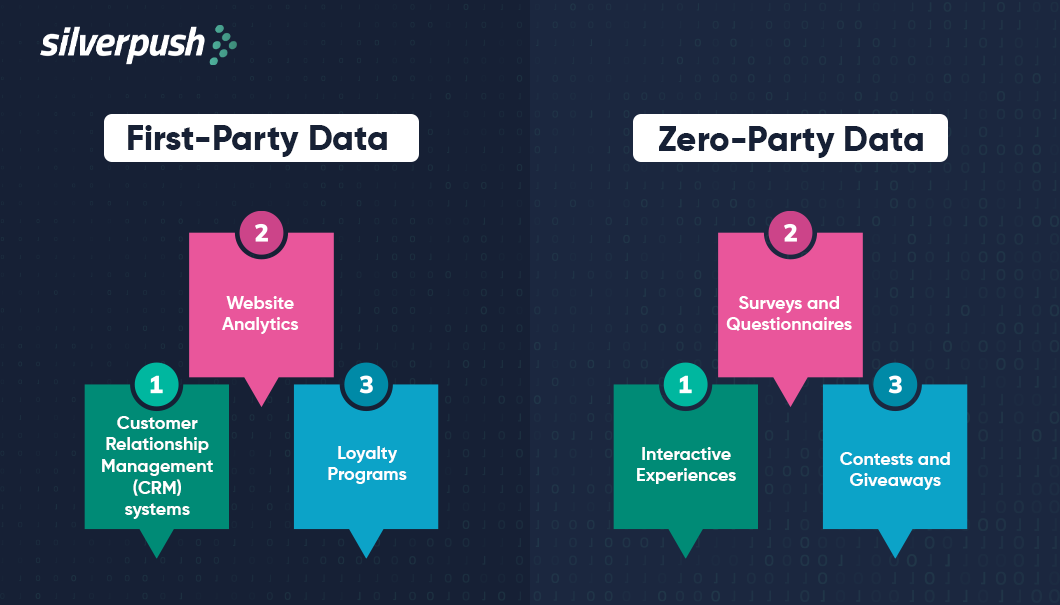
The advertising industry has entered an experimental era. Marketers use the hit-and-trial advertising approach. They have incorporated contextual advertising into their behavioral targeting and have begun to favor first-party and zero-party data.
But what are Zero and First-Party Data?
When information is shared with the intention and acknowledgment of the user it is zero-party data. This type of data includes customer preferences, interests, and opinions. Zero-Party Data can be collected in the following ways.
1. Surveys and Questionnaire: Brands ask questions or perform a survey to know the interests and opinions of the audience. For example, Nike surveyed to know which is the audience’s favorite shoe type among Air Force, Air Max, and Air Yeezy. This survey will give a fair idea about the audience’s interest in their product and with further analysis, Nike can target specific shoe ads to the specific user demographic.
2. Interactive Experiences: Companies can offer interactive experiences, such as quizzes or polls, that require customers to provide information about themselves. This can be a fun and engaging way for customers to share information with a company.
3. Contests and Giveaways: This way brands can easily promote themselves and collect the user’s data. For example, An FMCG brand posted a giveaway on Instagram where the user had to enter their details and tag 3 more people in the comment section. Through comments, the brand could get a large audience base and details of some users. Zero-party data is valuable because customers provide it voluntarily when they want to engage with a company.
According to 85% of marketing company respondents, zero-party data is essential for delivering effective tailored experiences. First-party data is passively collected by the brands. This data can include customer names, email addresses, purchase history, and website browsing behavior. The different methods through which first-party data can be collected is:
1. Website Analytics: Companies can use tools like Google Analytics to track website visitors and their behavior on the site, such as what pages they visit, how long they stay on each page, and whether they make a purchase.
2. Customer Relationship Management (CRM) Systems: Companies can collect information about their customers, such as their contact information, purchase history, and preferences, through their CRM systems.
3. Loyalty Programs: Companies can collect data on their customers through loyalty programs, which can track purchase behavior and offer personalized recommendations and promotions. First-party data is valuable because it helps companies understand their customers and provide more personalized marketing and customer experiences.
What’s the Key Difference Between First-Party and Zero-Party?
The key difference between first-party and zero-party data is the method of data collection. The method of data collection impacts user engagement and accuracy.
1. User Engagement: User engagement is much higher with the brand in zero-party because the consumer is directly engaged and has been sharing their information with consent. On the other hand, first-party data is passively collected. The data collected is based on the user’s interaction with the brand.
2. Accuracy: First-party data will involve analytical tools, to get precise information. The data is collected on behavioral targeting strategy which implies the use of analysis at the end. Whereas, the data provided by the user will be correct because the user wants to engage with the brand and wishes to avail the value provided by them in exchange for their information.
Conclusion
Overall, both types of data are valuable for companies as they allow for better understanding and targeting of customers. However, zero-party data is more likely to result in high-quality, personalized customer experiences as it is based on direct input from customers themselves. Another reason that would lead to the rise of zero-party data would be the consent of the user. Every day people are becoming conscious of their information which has already led to the phase-out of third-party data. Since the information gathered will be with the consent of the user, the privacy issues would be eradicated.
Video Contextual Advertising: Everything You Need to Know
PUBLISH DATE: 17 March 2023
Explore the world of in-video contextual advertising and master in creating engaging and personalized contextual ads for exceptional customer engagement.
As per current data, there are 3.1 billion digital video viewers worldwide, and online video is projected to account for 82.5% of all web traffic by 2023, making it the most preferred type of content on the internet.
With the increasing popularity of video content, more and more marketers are leveraging this medium to showcase their ads and expand their reach.
However, it’s crucial to note even the best advertisements, which have a feel-good factor about them, don’t perform well if they are fitted into irrelevant contexts.
Even a report from the University of Oxford supports this point. It observed that cheerful ads when inserted in between a gloomy part of the video don’t create much impact.
That’s why it’s important for advertisers to connect with viewers and convey their message in a relevant context. By carefully choosing where to place their ads within videos, advertisers can increase their revenue and create a more impactful experience for their target audience.
In this blog, we’ll take a closer look at what in-video contextual advertising means, its modus operandi, the benefits it offers for both advertisers, and some best practices for using this advertising method effectively.
What is In-Video Contextual Advertising?
In video contextual advertising, ads related to the content being seen or read are placed to ensure better connections with the audience.
Video ads can have more impact through in-video contextual advertising where in-video ads are placed relevant to the content being played out in the video.
This ensures that the viewer finds the advertisement to be closely related to what is being seen, and therefore, would be more interested in knowing the product.
They are typically triggered by specific keywords or phrases that are relevant to the video’s content, which helps ensure that the ads are relevant and engaging for the viewer.
For example, you’re watching a cooking video on YouTube. As you watch the video, you may notice that there are ads that appear within the content itself, such as a sponsored product placement for a particular brand of cookware or ingredients.
These ads are contextually relevant to the video content and provide value to the viewer by offering solutions or recommendations related to the topic at hand.
How Does In-Video Contextual Advertising Work?
Contextual advertising within videos relies on contextual data to deliver relevant and targeted video ads to viewers, based on the content they are watching. To achieve this, advertisers often partner with specialized contextual advertising companies like Silverpush, which have expertise in placing in-video contextual ads.
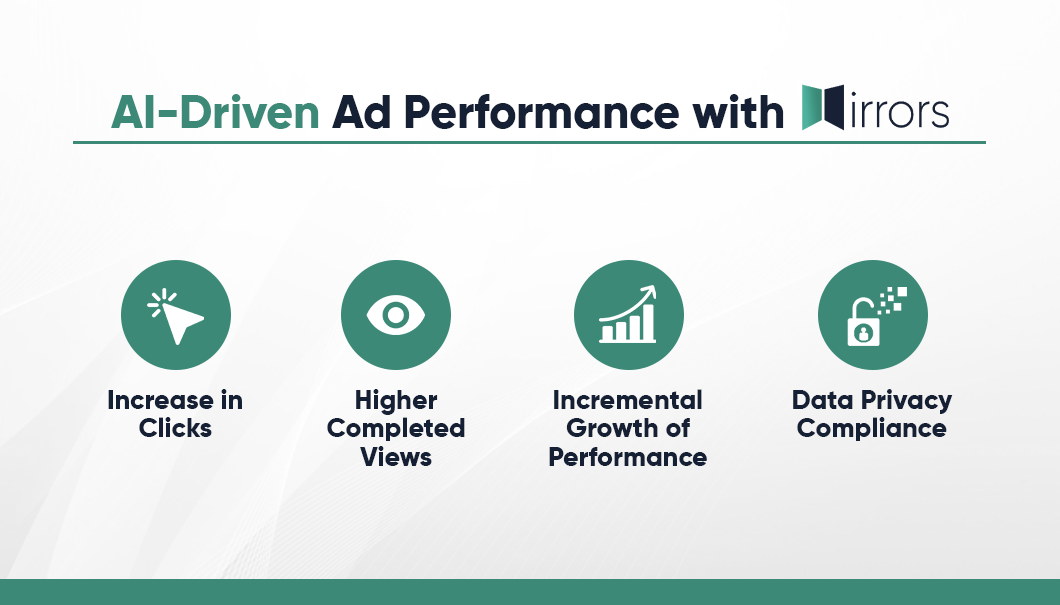
Silverpush’s flagship product, Mirrors is the world’s first in-video context identification technology. This hyper-contextual technology allows for more precise and effective ad placement within videos, resulting in a more engaging and personalized viewing experience for the audience.
Powered by AI, Mirrors performs video analysis to extract the right context. It identifies key contexts like celebrities, brands, objects, actions, and other context signals for a nuanced level of targeting at the video level and places ads accordingly.

In the past 5 years, Mirrors has processed 1.5B+ videos and built its own historic data intelligence to accurately determine which context performs best in each country. To know more about Mirrors contextual advertising platform and how it can help you in reaching your targeted audience, fill out the form on your right and an expert from our team will soon contact you.
Benefits of In-Video Contextual Advertising
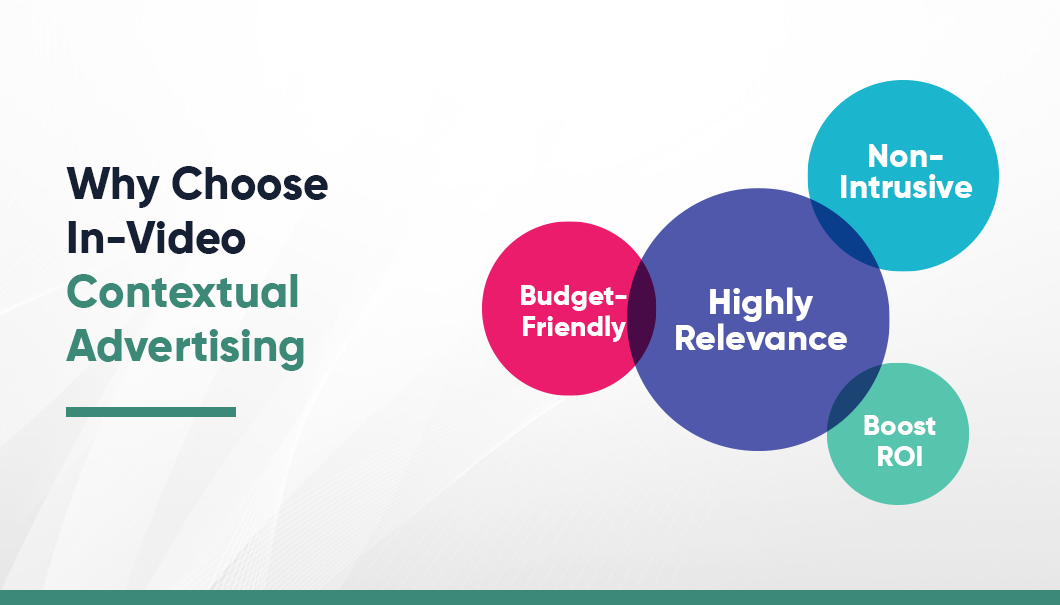
There are many benefits to using contextual video advertising for both advertisers and brands. Some of the key benefits include:
1. Relevance: In-video contextual advertising ensures that ads are relevant to the content that viewers are currently watching. This helps increase engagement and can lead to higher conversion rates for advertisers.
2. Non-Intrusive: In-video contextual ads are seamlessly integrated into the content itself, which makes them less intrusive and more enjoyable for viewers.
3. Cost-Effective: In-video contextual advertising can be more cost-effective than traditional video advertising because it allows advertisers to target specific audiences more effectively.
4. Increased Revenue: In-video contextual advertising can increase the revenue of brands by experiencing an uptick in their ROI.
Best Practices for In-Video Contextual Ads
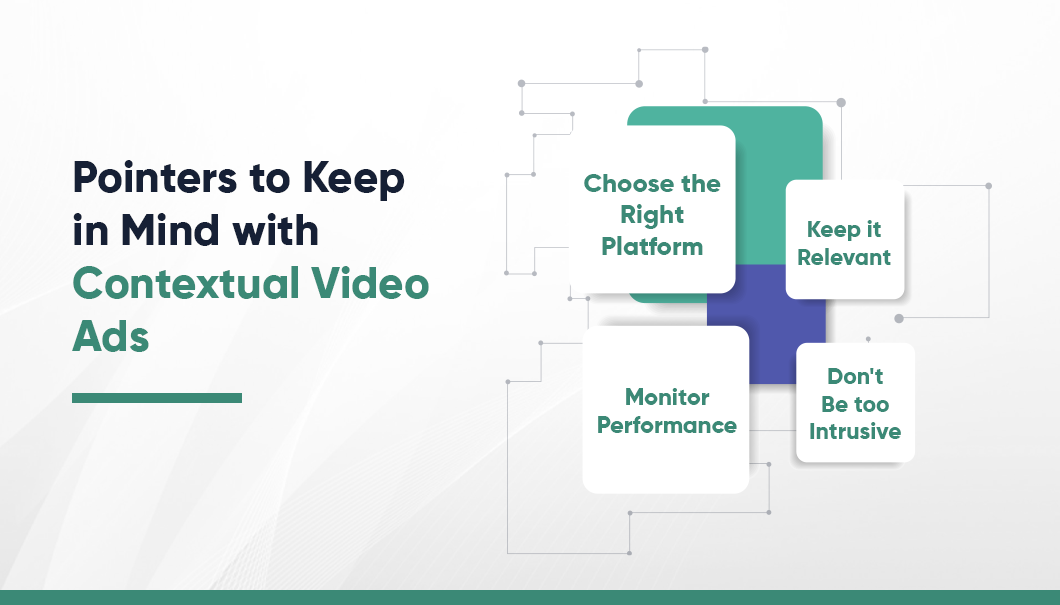
If you’re considering using in-video contextual advertising as part of your marketing strategy, there are a few best practices to keep in mind:
1. Choose the Right Platform: There are many different platforms and networks that offer in-video contextual advertising, so it’s important to choose one that is a good fit for your audience and budget.
2. Keep it Relevant: Make sure that your ads are contextually relevant to the content that viewers are currently watching. This will help increase engagement and conversions.
3. Don’t Be too Intrusive: Contextual video ads should be seamlessly integrated into the content itself, without being too intrusive or disruptive.
4. Monitor Performance: Keep a close eye on how your ads are performing and make adjustments as needed to optimize for better results.
Unlock your Revenue Potential with Mirrors In-Video Contextual Advertising
Mirrors’ cutting-edge in-video context identification technology can help your brand place the right content at the right time in a video, increasing the likelihood of your ads resonating with viewers.
With Mirrors, you’ll be able to create a more engaging and personalized viewing experience, resulting in more impressions and clicks on your ads. Don’t miss out on this opportunity to elevate your brand’s advertising game. Contact us today!













